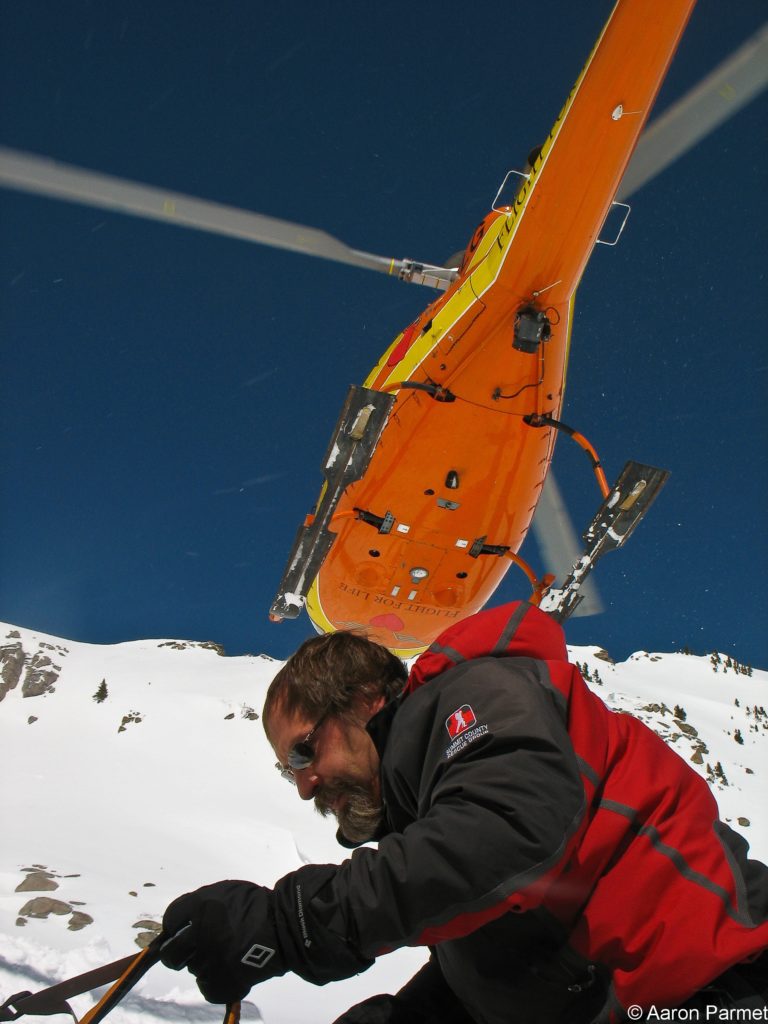Published by Summit Daily News on 10-14-2008
My hair was half cut when the pager went off. “All available search and rescue members, report to the Peru Creek trailhead for an avalanche with one confirmed burial.” I leapt out of the salon chair and grabbed my purse.
“I’m really sorry, but I have to go,” I told my hairdresser.
“But your hair is only cut on one side!” she protested. “And it’s still wet!”
“I know. It’s OK!” I shouted on my way out the door. “I’ll call you to reschedule!”
Peru Creek is off the Montezuma Road, between Keystone and the eccentric little town of Montezuma, and it takes a good half hour to get there. I rushed not because it made any sense to rush, but because we’re conditioned to rush for an avalanche; it’s reflexive behavior. The truth, however, is that in the time it takes us to arrive on scene, a buried person has about a 10% chance of survival because they only have an average of 30 minutes of oxygen before they asphyxiate.
The first person I saw at the trailhead was Aaron. “I was skiing nearby when the call went out,” Aaron told me. “I wouldn’t even have known except I saw the Flight for Life chopper flying low overhead.”
“So what’s happening now?” I asked him.
“A dog team went in from Loveland, and a team skied in from Arapahoe Basin,” he said. “They dug out a woman and flew her out already, and she’s OK. We can’t find the reporting party though; he’s probably buried in the second slide.”
Joe Ben, the mission coordinator, shouted, “Aaron! You’re towing in with Reller and Zak behind Chad’s snowmobile. Get going.”
Aaron sped off with his skis. A short way up the trail, I watched Flight for Life land and pick up Aaron, John Reller and his dog Tracker. The chopper took off and flew low up the valley toward Chihauhua Gulch.
I didn’t get the rest of the scoop until later, but Aaron’s story was dramatic. He told me they could see huge chunks of cornice in the debris field, as big as the helicopter itself. The main slide was about 800 feet long, and there was a second one almost as large next to it. He could see the snow disturbance where the first victim had been extricated. Tracker, a certified avalanche dog, began searching while Aaron and John joined the other probers. They hurried, because an enormous cornice loomed overhead and the pilot had warned them that a crack was widening as the weather warmed.
Not long after they arrived, Aaron spotted a man walking up from the valley. John shouted to the man, “Are you the reporting party?” And he was! Incredibly, he was unharmed. He told his story as rescuers hiked him out; he and his companion, both experienced mountaineers, were climbing one of the nearby peaks when a cornice broke loose and the woman plunged down the gulley with it. They didn’t have avalanche gear. He thought of going after her but opted to follow the ridge instead. He called 911 before he started walking. A second cornice break set off another avalanche, but he was fortunate to avoid it. Then he walked down into the valley, staying on a relatively safe ridge.
The Peru Creek call was unusual in that both victims survived. As with most avalanche accidents, there are lessons to be learned. Cornice collapses are one of the most frequent causes of death for mountaineers, and clearly, the climbers should have avoided the edge. They should also have been aware of the aspect of the terrain they were traveling in, which was southeast facing and had warmed quickly. They should have watched for telltale signs like “whumping” noises and cracking, although these don’t always happen. They should never have assumed they didn’t need avalanche gear, even when they intended to avoid avalanche terrain. Backcountry travelers should always carry a transceiver, probe pole and shovel and know how to use them. Finally, the reporting party’s call could have given more detail about his plans. If we’d known he was hiking down the ridge, we wouldn’t have been looking for him in the second slide.
The reporting party also did some things right: he made the 911 call immediately, before he began hiking down, and he resisted the temptation to jump in from the top to rescue his companion, staying in safer terrain on the ridge instead. He chose a safe route back into the area where she ended up, and that decision probably saved his life.
The average visitor to Summit County will never see this kind of danger, because ski patrols control for avalanches within ski area boundaries. But if you have a hankering to try your hand at backcountry skiing or winter climbing, educate yourself before you go. Get a good book on the subject (Snow Sense by Jill Fredston and Doug Fesler is our suggestion), consider taking a class, and consult the state’s premier resource for snow safety: the Colorado Avalanche Information Center. The CAIC has been serving Colorado backcountry recreationalists since 1973 and puts out a twice daily avalanche forecast on its website. As a state organization that exists largely on public donations, their funding has been unfortunately cut this year, causing them to need further public support. To help, and for avalanche information, call 970-668-0600, or visit http://avalanche.state.co.us.
Stay safe out there this season—we don’t want to meet you by accident!


Comments are closed.